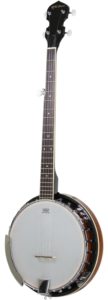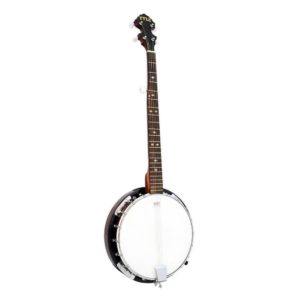What is the best banjo for beginners? We know the right answer.

Perhaps you’ve chosen to master playing the banjo, or maybe you’ve had a few lessons and have decided that owning your banjo would help you get in a bit more practice.
If you’ve clicked to read this, you’ve probably figured out by now that deciding on your first banjo isn’t all that easy.
Do you want a 4-string or maybe a 5-string? A closed-back or open back? What the hell is a geared 5th string? Should I get one with a tone ring?
Many questions, but never fear, this is the guide to help you on your way to banjo domination.
Top 4 Best Banjos for Beginners:
| Image | Model | Price |
|---|---|---|
 | Pyle PBJ60 Banjo (Top Pick) | Check Price |
 | Jameson 5-string Banjo | Check Price |
 | Epiphone MB-100 Banjo (2nd Best Choice) | Check Price |
 | Oscar Schmidt OB5 Banjo | Check Price |
Pyle PBJ60 Beginner Banjo Review (Editor’s Choice)
The Pyle-Pro PBJ60 is a great banjo for beginners. The build quality is decent, but I can’t say it’s something similar to what professionals use.
The build materials are of reasonable quality with a mahogany neck and back, but the performance and sound are just a little underwhelming from a professional point of view. The low fifth string friction tuner makes it an effort to tune the banjo, and even then, it doesn’t stay in tune for long.
Those minor issues aside, the PBJ60 is good as the other banjos here. Sure, you could improve it without too much investment, and most first-time players will be more than happy. Its price is unbeatable and I don’t think that beginners should use a lot of money on their first banjo.
So, let’s be clear: it’s a good instrument to start from. But, of course, you’ll need a better banjo as soon as you get some experience.
Pros
- The mahogany neck and resonator back
- Very low price
Cons
- Average build quality
- The neck bends with limited pressure
- Fifth string tuner is not geared and often not fitted correctly
Epiphone MB-100 Beginner Banjo Review
The Epiphone MB-100 is the best banjo for beginners and a beautiful instrument with a straightforward, understated design.
Its lovely warm sound is a joy to hear, and the fact that there is no resonator makes it a lightweight banjo to travel with. It’s not very loud, which is expected with an open back, but charming tone.
Unfortunately, it doesn’t have a tone ring, which might not bother the traditionalists out there, but it’s a negative for me.
A geared fifth string would also need to be added to avoid constant retuning. I think it’s a shame that this isn’t standard on all banjos, considering how little it would cost.
Overall it’s not a bad banjo. It’s well made with quality parts from a name that you can trust at a fantastic price.
The neck appears to be one piece mahogany and seems stable, although a little on the slim side, which may be a struggle for those of you with larger hands.
The rim is also mahogany and helps deliver that lovely warm sound, although a tone ring would undoubtedly brighten things up a bit.
Pros
- Elegant looking banjo
- Good value, with quality parts
- Good tone
- Low weight, great for traveling
Cons
- No tone ring
- Low volume (although this makes it great for practicing without disturbing the family)
- The fifth string isn’t geared.
- No resonator
Oscar Schmidt OB5 Beginner Banjo Review
The Oscar Schmidt OB5 is a nice banjo that is packed with features for a fantastic price. This banjo is a closed-back beauty with a geared fifth string and a cast aluminum tone ring.
The OB5 may not be as pretty as the MB-100, but it is still a fantastic-looking banjo. The tones are bright and punchy, and the geared fifth string helps the banjo hold its tune.
The neck size is a little on the small side (as it is on the MB-100), so those of you with larger hands may struggle, although this is a real plus when buying for a child.
The OB5 has a mahogany (removable) resonator and a nato neck (nato wood is considered closely comparable to mahogany), which will give a fantastic sound when set up correctly.
Unfortunately, the build quality could be better, and for those of you who like to order online, the internet is littered with reports of faulty units being shipped to customers.
Some customers have also found that pressure on the neck during play can cause the banjo to flex, which affects the tune.
Pros
- Low weight, great for traveling
- Bright, punchy sound
- Aluminum tone ring
Cons
- Build quality could be better
- Neck flexes under pressure
- Geared fifth string
- Low weight. Great for traveling (even with the resonator on)
- Removable resonator
- Quality materials
Jameson Guitars 5-string Beginner Banjo
The Jameson Guitars 5-string Banjo is a first-class, stunningly attractive banjo for a low price. It’s well made with high-quality materials such as a mahogany neck and resonator and a three-ply maple rim.
The removable resonator adds to the banjo’s versatility. This banjo handles anything you throw at it, from Bluegrass to jazz and even rock.
On top of all that, it’s by far the sharpest looking of the bunch. It is a thing of beauty that should last many years, from the rosewood fretboard with a nickel-plated armrest to the mahogany resonator.
The only thing missing is the addition of a tone ring, but to be honest, the sound from this banjo is already so lively and bright, I’m not convinced it’s needed.
In the search for something negative to say, there have been limited reports of the geared fifth string tuner not being set correctly, so if in doubt, please have this checked by a professional before the first tune.
Pros
- Exceptionally bright and lively sound
- Removable resonator back
- Lightweight
- Holds tune well due to geared fifth string
- Well made with quality materials
- Looks amazing
Cons
- Geared fifth string tuner has been reportedly set incorrectly on some models; please check before tuning.
- No tone ring
Best Beginner Banjo Basics
Types of Banjos
In the last few years, the banjo has been making a comeback, which has upped the interest and led to more people wanting to learn to play. However, there are many different types of banjo out there, and the whole thing can be a bit daunting for someone new.
It’s important to say that the first banjo you acquire will almost certainly not be the last. You will likely experiment with lots of different play styles, and a versatile banjo is therefore very important.
A quick search on Google will communicate that there are banjos with 4, 5, 6, or even 12 strings; closed backs, open backs, and removable backs.
Plenty of people gets hung up on the number of strings a banjo should have and are often pushed into a playing style to suit the banjo. Sure, 4-strings can be easier to play, but 5-string banjos are more versatile, and as I said, versatility is vital for the aspiring banjoist.
But let’s break things down and talk about some of the differences.
Main Banjo Features
There are many features and materials which combined make the perfect banjo. Understanding these features is an essential part of choosing the perfect banjo for your budget.
Below are details of some of these features, which should assist you with your decision for the perfect banjo:
Neck
The neck of the banjo or fretboard is generally made of wood. This is because the banjo’s neck must be rigid, so that pressure on the neck doesn’t cause movement, which, in turn, can affect the tuning. For this reason, on higher-end banjos, the neck is usually made from one piece of wood.
The lower-end, cheaper banjos, on the other hand, have a neck generally made using laminated pieces of wood. That does not necessarily pose a problem, but it is crucial to ensure that the banjo’s neck flexes too much.
Resonator
The resonator is simply the back of the banjo. You will often hear banjos described as either open or closed back. If a banjo is open-backed, it doesn’t have a resonator or back plate behind the strings. If a banjo is closed-backed, then it has a resonator. It seems obvious enough!
However, the resonator affects the tone and volume of the banjo. It acts as a reflector, which forces the sound from the strings directly towards the audience. Or, in the beginner’s case, towards your reflection in the mirror!
If a resonator hasn’t been fitted, some sound will be lost and absorbed by the musician’s clothes and body rather than projected towards the audience.
It is often said that resonator banjos are more suited to the Bluegrass style. That is undoubtedly true. It is important to remember that you can play any musical style on any 5-string banjo.
You will also find that many “closed back” banjos have removable backs and can, therefore, give either option. Some prefer the open back only because of the reduced weight.
Tone Ring
A tone ring is a metal ring fitted to some more modern banjos and changes the produced sound’s tonal quality. Banjos with tone rings fitted are generally preferred by musicians who want a brighter, more modern, lively sound.
Rim
The banjo’s rim is the central assembly part of the body and is usually made of multi-ply wood. Together with the tone ring, the rim is a significant part of the sound from the banjo.
The Best Banjo for Beginners: Our Verdict
I’m sure it won’t surprise you to find that my winner is the Jameson Guitars 5-string Banjo. It surpasses its competitors.
The construction is solid and beautiful, with real attention to detail.
The sound is bright and lively with excellent tonal quality. The removable resonator back is elegantly implemented and adds to the banjo’s versatility. It is a fantastic banjo for beginners but one you won’t outgrow for some time.
I have already mentioned I’d prefer a tone ring, but the banjo sounds just fine without one, so if it isn’t broken.
We should also note that the Oscar Schmidt OB5 is an excellent banjo if you get a good one! Unfortunately, the many adverse reports from customers receiving faulty banjos can’t go unnoticed.
If you’re desperate to get one of these, I would either order online – ready to use the returns process or buy from a store where you can inspect the banjo before purchase.
Personally, my thought, for the price, the Jameson Guitars 5-string Banjo can’t be beaten, and it’s the best beginner banjo at the moment.